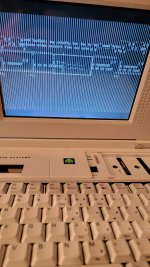Cap layout and board sure do look the same to me: https://macdat.net/cap_reference/apple/powerbook/180c.html
In any event, good luck getting it fixed!
In any event, good luck getting it fixed!

I know this is stupid, but would there be any way I could solder chip sockets to the solder pads? I think there's just enough clearance between the boards to allow for that. It would make the process of changing chips far quicker. As for the chips themselves, they're just through-hole chips with their legs bent underneath for SMD purposes.
Would there perhaps be a tester of sorts that could check to see which of these chips are good or bad?

Those are SOJ style ICs, but I don't know of any common socket that would fit those chips, because those specific chips are not designed to be socketed. While they only have 20 pins, they'd be classified as 26 pin devices, since there are 13 pins on each side, even though 3 of them on each side are not populated.
28, 32 and 40 pin SOJ sockets exist, but I'm not finding any 26 pin sockets. I'm sure there was probably a test socket made for that package type, but it's going to be decades obsolete by now, and difficult to find if any still exist.
There's the Retro Chip Tester Pro, but it's hideously expensive.

Retro Chip Tester Professional - IC Integrated Circuit Tester Pro | eBay
Find many great new & used options and get the best deals for Retro Chip Tester Professional - IC Integrated Circuit Tester Pro at the best online prices at eBay! Free shipping for many products!www.ebay.com
$470 for the fully assembled version.
A cheaper method would be to find an old RAM module with similar memory chips and swap them out for the ones you want to test and use a PC to test them. If you find any bad bits, you can use the memory map to figure out which chip is bad.
From the looks of it, it's a five volt chip, and the L means low CMOS current needed for data retention.The "low power" design can be a gotcha. Does low power mean the IC was redesigned to use less current, or does it mean that it requires less voltage? In the FPM/EDO era, memory was starting to change over from 5v to 3.3v. On memory modules it didn't matter, because they just added level shifters. In memory chips directly on the board, it does matter because if you put a 3.3v chip in place of a 5v chip, it's going to die. It may work for a bit, but it won't be long before it burns up. To add to the complexity, there's a third wheel, 3.3v devices that are 5v tolerant.
Memory technology in the 90s was fun.
Yeah, I'm not liking that memory chips like these are losing their ability to hold information. I have an S3 Virge that needs some memory, and it seems like the memory I got was just as bad as yours.
Why are they doing this? I'm assuming it's age related.
Another thing that frustrated the finding of these chips are the MOQs that a lot of distributors have. I don't need 50 of the same DRAM module, I need four. Such is life, I suppose: endless frustration.
There's the Retro Chip Tester Pro, but it's hideously expensive.

Retro Chip Tester Professional - IC Integrated Circuit Tester Pro | eBay
Find many great new & used options and get the best deals for Retro Chip Tester Professional - IC Integrated Circuit Tester Pro at the best online prices at eBay! Free shipping for many products!www.ebay.com
$470 for the fully assembled version.
